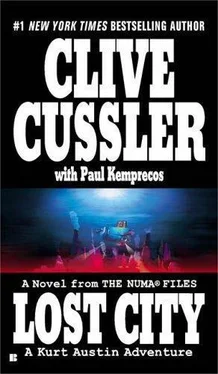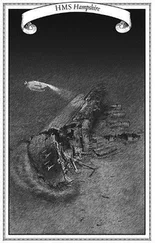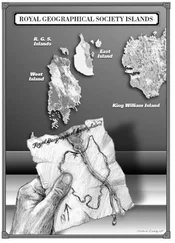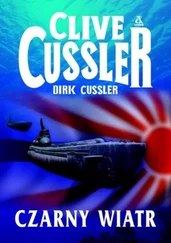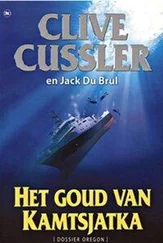He selected the engraved area with his cursor, zoomed in, refining the image as he enlarged it, until he could see the name of the manufacturer and a serial number. He leaned back in his chair and stared at the image for a moment, and then he reached for a phone that could connect him anywhere in the world and punched out a number.
"Orville and Wilbur's flying bike shop," said a reedy voice. Austin smiled as he pictured the hawk nose and narrow face of the man at the other end of the line. "You can't fool me, Ian. I happen to know that the Wright Brothers closed their bicycle shop a long time ago."
"Hell, Kurt, can't blame me for trying. I've been up to my earlobes trying to raise private funds for the Udvar-Hazy Center out at Dulles airport and I don't want to waste my time with small talk."
Ian MacDougal was a former marine fighter pilot in charge of the archives division at the Smithsonian's Air and Space Museum. He was the airborne equivalent of St. Julien Perlmutter, whose extensive library of nautical books was the envy of many academic institutions, and whose grasp of sea history was known the world round. The tall and lean MacDougal was the physical antithesis of the rotund Perlmutter, and he was far less flamboyant, but his encyclopedic knowledge of aircraft and their history matched St. Julien's grasp of the sea. "You can rely on me for a hefty contribution, Ian, and I'll try to spare the small talk," Austin said. "I'm in France and I need to identify a plane I found at the bottom of a glacial lake in the Alps."
"I can always depend on you for a challenge." MacDougal sounded delighted to be distracted from fund raising. "Tell me about it." "Crank up your computer and I'll send you some digital photos." "Consider it cranked." ^
Austin had already programmed the photos for transmission, and the pictures taken at the lake bottom whisked on cyber wings across the Atlantic in a millisecond. MacDougal had stayed on the line and Austin could hear him muttering to himself. "Well?" Austin said after a few moments.
"I'm taking a guess, but from the distinctive cone-shaped engine housing, I'd say we're looking at a Morane-Saulnier. She was a World War One mono-wing fighter plane based on a racing plane. The little buzzard could out fly and outmaneuver almost any other fighter aircraft of the day. The gun and propeller synchronization setup was truly revolutionary. One of the Allied planes crashed, unfortunately,
and Fokker copied the system and improved upon it. There's a moral there somewhere."
"I'll let you deal with the moral complexities. Given what you know, do you have any idea how this plane got to the bottom of the lake?"
"Fell out of the sky, obviously, which is what planes sometimes do. I can guess on the rest, but I'd probably be wrong. I do know someone who might be able to help you. He's only a couple of hours from
Paris."
Austin jotted down the information. "Thanks," he said. "I'll get my museum contribution to you as soon as I get back to Washington. In the meantime, give my regards to Wilbur and Orville."
"I'll be glad to oblige."
Austin hung up, and a moment later he was calling the number Ian had given him.
SKYE SLAMMED the cover down on the thick reference book she had been reading and shoved it across her desk to join a tall stack of similar well-worn volumes. She hunched her shoulders and stretched her arms to work the kinks out of her muscles, and then leaned back in her chair, lips pursed, and stared at the helmet in front of her. She had always considered ancient weapons and armor simply as tools, nothing more than inanimate objects used in the bloody business of war, but this thing made her shiver. The oxidized black surface seemed to exude a malevolence she had never before encountered.
After she had returned to Paris, Skye had taken the helmet to her office at the Sorbonne expecting that identification would be easy with the reference tools at her command. She had photographed the helmet, fed the images into her computer and searched through an extensive database compiled from hundreds of sources. She had started with her French archives, and then moved on to Italy and Germany, the countries that were once the primary armor centers.
Finding no match, she'd expanded the country search to take in
all of Europe, and when that search had bottomed out she moved to Asia and the rest of the world. She combed records going back as far as the Bronze Age. After the computer search fell flat, she turned to the printed page and exhumed every musty reference book in her library. She pored over old prints, manuscripts and ivory and metal carvings. In desperation, she researched the Bayeux Tapestry, but the conical headgear its warriors wore in battle bore no resemblance to the helmet sitting in front of her.
The helmet was a contradiction. The workmanship was extraordinary and more characteristic of an ornamental than a war helmet, although the nicks and gouges marring the surface suggested that it could have been worn in battle. The apparent bullet hole was a puzzle all to itself.
The design suggested an early origin. The weight was borne by the head as in the earlier helmets. Later models had an armet, the flared bottom that allowed the weight to be transferred to the shoulders via a collar called a gorget. The helmet was topped with a fan-shaped crest, another later innovation that added protection from a mace or sword.
Helmet style evolved from the conical shape in the eleventh century to rounded helms in the twelfth century. The nose guards had expanded to protect the face, developing eye slits known as "sights," and ventilation openings called "breaths" came into being. German helmets tended to be heavy and spiky; the Italian models were rounder, reflecting the Renaissance influence.
The most extraordinary thing about this helmet was the metal. Steel manufacture had started as early as 800 B.C." but it took hundreds of years to develop metal of such high quality. Whoever had forged this metal was a master. The strength built into this helmet's steel was evident in the dent in the crown known as a "proof mark." Someone had tested the metal with a pistol, or arquebus, and it had proved itself impenetrable. But as the bullet hole showed, each rise
in the efficiency of defense produced a corresponding response in the effectiveness of attack. Armor finally became obsolete in the 1522 Battle of Bicocca. The enemy was gravity, rather than projectiles; armor simply became too heavy to wear.
The face embossed on the visor was typical of sixteenth-century Italian armor. Artisans avoided embossing in combat helmets. Surface features had to be smooth and round, or shaped with planes to offer a glancing blow. Embossing could destroy the effectiveness of a glancing surface. She picked up her letter opener, actually an Italian dagger, and tried to catch the edge and point in the helmet. Despite the embossing and etching that covered the helmet, the metal had been cleverly fashioned to shed the blows.
She came back to the steel again. No detail distinguished one armorer from another more than his ability to temper metal. She rapped her knuckles on the helmet, which gave forth a clear, bell-like sound, and then with her forefinger she traced a five-point star with "legs." She turned the helmet around. Seen from another angle the etching depicted a shooting star. She recalled seeing a sword from an English collection that had been made with iron from a meteorite. The steel was capable of being sharpened to a razor's edge. Why not a helmet? She made a note to have a metallurgist check it oufT
Skye rubbed her tired eyes, and with a resigned sigh she reached for the phone and punched out a number. A man's voice came on the line. It was deep, and pleasantly cultivated. "Oui. Darnay Antiquites." "Charles. It's Skye Labelle."
Читать дальше
